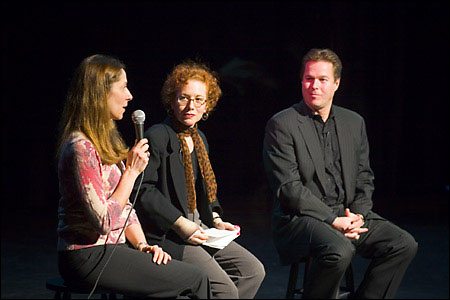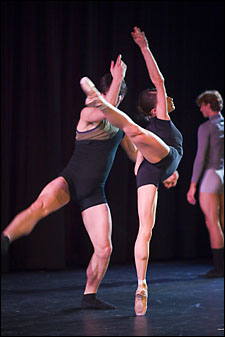Boston Ballet premieres its ‘Grand Slam’
Harvard Dance Center hosts presentation of ‘classico-modern’ dance
The Boston Ballet came to Harvard last week (Feb. 23) to present a preview of the ambitious program it’s presenting later this month (March 16-26) at the Wang Center: an extravaganza the company is unabashedly calling “Grand Slam: Four Powerful Works, Four Intriguing Choreographers.”
The presentation gave Harvard dance students an opportunity to hear and see up close how the lines between classical and modern dance are blurring; what it is like for classically trained dancers to face the challenge of improvisation; and how important it is, both for companies and for individual dancers, to be involved in the creation of new works.
Elizabeth Bergmann, dance director of the Harvard Dance Center, introduced a delegation led by Mikko Nissinen, artistic director of the Boston Ballet. The group included 10 members of the corps, who danced excerpts from “Grand Slam,” which consists of two world premieres, a company premiere, and a revival by Jorma Elo, choreographer in residence at the ballet.
The company premiere is “Lambarena,” an exuberant work by Val Caniparoli, whom Nissinen characterized as a choreographer second only to George Balanchine. That the score of “Lambarena” draws on music by Johann Sebastian Bach as well as traditional African music gives some indication of how eclectic “classical dance” is becoming.
One of the world premieres is “Etesian,” with a score by Bach and Beethoven. It’s the first work for a major company by Helen Pickett, a dancer and student of the pre-eminent contemporary choreographer William Forsythe.

Pickett’s partly improvisatory work is “based on classical movement, but with a contemporary edge,” ballet mistress Jennifer Glaze said. Pickett is interested in incorporating individual dancers’ flair into the movement, Glaze explained. But the choreographer’s demand for improvisation at first panicked some members of the company into resembling, as Glaze put it, “deer in the headlights.”
Pickett persisted, the ballet mistress recounted, telling the group, “The floor is yours. Enjoy.” Eventually the dancers’ resistance melted, and they entered into the spirit of the piece.
Nissinen related with a chuckle how one dancer told Pickett early on,”Helen, I am not a choreographer.” But she won him over, Nissinen said, adding, “She turned that dude around.”
Nissinen stressed the importance of new works to a company. “I want Boston Ballet to be known, as Boston is, as a gateway,” he said, and being able to present new choreography is part of that.
“Believe it or not, ‘Swan Lake’ was a new ballet once upon a time. In 1877 it was a groundbreaking work.”

However valuable the experience of learning the classics is, he said, “It is a more profound experience of growth to be part of the creation of a new work.”
Glaze expanded on this observation, with an example of a dancer whose unrehearsed movements off at the edge of a rehearsal might attract the attention of a choreographer who then seeks to incorporate those movements into the dance, in effect turning the dancer into a collaborator:
“To be a dancer just futzing around at the edge of things, and to hear the choreographer say, ‘What was that you just did? Where can we take that?’ – where can we take that?” she repeated for emphasis, “That’s a very, very special place. It doesn’t happen too often.”
Susan Larson, dance administrator of the Harvard Dance Program, said that the Boston Ballet Talk is part of the “multifaceted relationship” between the program and the company. Boston Ballet staff teach most of the University’s advanced ballet classes, in the form of a series of master classes. Harvard students are also invited to sit in on dress rehearsals of the ballet’s productions, where they are able to observe last-minute changes or other bits of artistic direction they would never otherwise see.
“What we hope we’re doing is enriching them with technique, but also giving them insights into how the ballet world functions,” Larson observed.
The questions at the end of the presentation Thursday night reflected interest in the practical realities of the world of dance: “Who does the casting of a ballet?” “How is the company organized?” And finally, “For the Helen Pickett piece, where they got to improvise – was it pretty much set then, or will they still be improvising when they perform it?”
Said Glaze: “There will still be some improvisation.”




